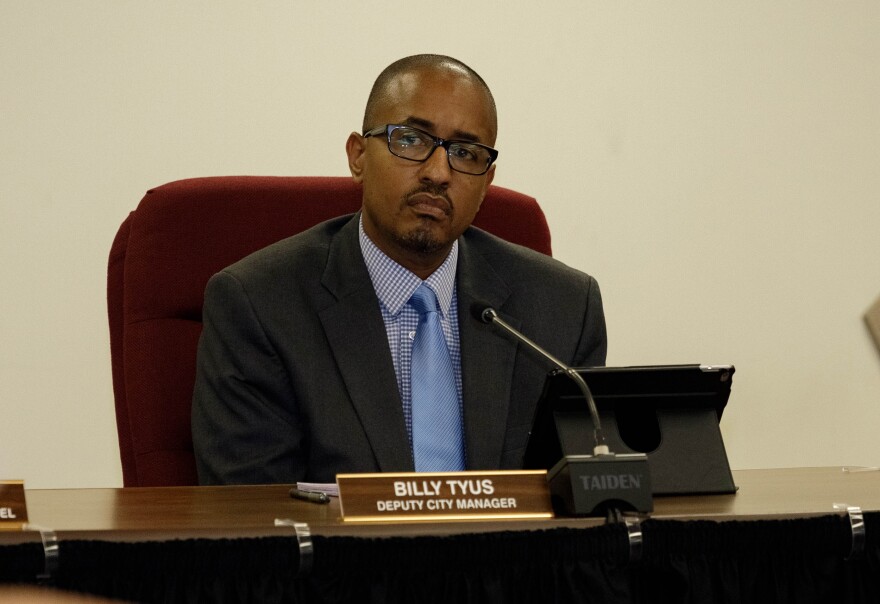For more than a year, the city of Bloomington has been looking into a new streetscape plan. It's potentially a $30 million "generational" project that would replace aging under- and above-ground infrastructure. Staff have said the effort is about far more than beautification.
Until now, the project has been mostly quiet. That is changing.
There's a public input and reaction session set for 4-7 p.m. Oct. 11 at the Bloomington Center for the Performing Arts, where city officials said they they plan to share some ideas on how to transform downtown. The city hired a Springfield consulting firm last year to collect data and come up with ways to improve walkability, sidewalks, lighting, and other downtown features.
Deputy City Manager Billy Tyus said until now there have been a lot of background conversations needed before the city could approach the public. Tyus said the city wants public opinion on aesthetic as well as infrastructure issues. The city has even created a web site to facilitate that.
"You can go towards more modern concepts in your design and build. You could go towards more historic designs and builds in the materials you use and the lighting you use and the landscaping you use and the planners you use, those things," Tyus said on WGLT's Sound Ideas.
He said it's even possible there could be a hybrid style, mixing modern and historic. And then there's the always touchy issue of parking.
"Conceptually what do you think public? Perhaps this as a change in how we handle parking versus that as a change, locations for parking and that kind of thing," said Tyus.
There have been many false-starts on downtown revival over several decades; unfunded plans, partially funded initiatives, plans detailed by recessions and city council cold feet. But Tyus said this time is — city council willing — different.
"Those plans were not done in vain. Our designers and our plan team utilized those plans as part of the work they are doing now to get us to this point," said Tyus.

It's possible to have specs and bids out for a new streetscape by the middle of next year, said Tyus, who thinks this plan already has advanced further than all the other revitalization efforts.
The city also has started a website for the public to get an idea of plans as they firm up and a place to have input.
Tyus also said the work over the coming months will narrow the cost estimates of the potential $30 million effort.
“It's something you don't have to bite off all at once," he said. "This is something that could be broken up into different projects and in different phases.” .
The city also is hopeful the project could attract grant money to defray the admittedly large sticker price.
“There are tools, like TIF districts and business districts. There is federal funding out there to help fund shovel-ready projects. That's why this design work is so important,” said Tyus.
Public Art Commission
In October of 2020, the city council passed a resolution to create a Public Art Commission, after initial questions about who would select the art and pay for it and who would serve on the commission.
Tyus acknowledged the commission still has not been established.
“It is something that we're talking about how to best move forward. Public art is also part of the streetscape project. One of the things that has happened is there is there has been a review of whether the commission as it was established, is the best way to pursue public art. And so we I don't have an answer to that as of yet,” he said.
It’s unclear what needs to be reconsidered after the council expressed direction. The ordinance called for the mayor to appoint three members to the commission, and for some members of the existing Cultural Commission to serve on the art panel as well.
“It hasn't been a situation where staff said, wait a minute, we're not going to do this," said Tyus. "What I am saying is that after that occurred, for various reasons, the commission did not get established. It's not something that we've done, as of yet. It may very well be that is what happens. But in the midst of all of this, other questions arose as to whether there were other considerations as to how to handle public art. And so it just hasn't happened as of yet. I know, it's been a very, very long time. But it just hasn't happened as of yet.”
He said the commission remains an important body.
“It absolutely is a high priority. Public art is something the public wants. Secondarily, it is a part of the streetscape design that we are currently considering. That will be in the plan that will come forward as well. There has to be a process for managing it. I mean, there's no excuse for it having not move forward. Now, I'm not making one. But what I will say is that it is something that I would anticipate will happen very soon,” said Tyus.
There was an original budget line item of $25,000 for this purpose. Tyus said whatever was in the ordinance will still be available, adding he thinks an intention to create the commission was to encourage outside private or organizational investment in public art, too.
White Place neighborhood concern
Neighbors of a White Place project to remodel a house have not been happy about it. They've protested that the apartment units in a structure at the north end of White Place cut against the character of the mainly single-family residential neighborhood. They've argued that it's even counter to existing zoning codes. City staff promised to meet with council members to talk about the issue.
Tyus said that is ongoing, acknowledging the neighbors do not agree with staff interpretation and reading of the zoning code as it relates to the property in question.
The building is considered a legally allowed non-conforming use. It has nine units in a district that today wouldn't allow that. It’s legal, said staff, because the house was sub-divided into apartments before the existing code limited the number of units for that class of house and that kind of neighborhood.
“It's been a nine-unit apartment for decades,” said Tyus. “The owner is renovating and repairing the building. They're not expanding the number of units or making the non-conformity worse. It's a big renovation, but that's allowed by code,” said Tyus.
Neighbors have argued the property has been vacant for more than a year and that vacancy should cause the non-conforming use status to lapse and trigger more modern code limits. Tyus said that is not the case.
“The legal requirement for abandonment is not the same as the appearance of vacancy. You have to show there was an intent to abandon the use, not that it appears to be vacant. Our planning, legal, and economic development staff has looked at that. What we've seen based on registrations, based on water records, based on other information, is that that has not occurred,” said Tyus.
He noted there are other legal non-conforming use properties in the neighborhood.
Tyus said if the council desired to reconsider the zoning codes and the impact on the character of a long-established neighborhood, that could happen, but it might not change what happens with this property.
He said if a non-conforming use is disallowed without proof of vacancy, it could impair the value of a property compared to when it was purchased.
“There are state and federal statutes related to individual property rights, that you have to be very careful not to impede as you consider potential changes,” said Tyus.
Trees and more trees
Surface temperatures recorded in the Twin Cities during the August heat wave showed 20-to-40-degree differentials between open pavement and shaded areas. Climate change could further affect such readings. Temperature differences between affluent and low- and moderate-income neighborhoods also tend to be significant.
Tyus said the Parks and Recreation Department plants about 500 trees per year in Bloomington and manages more than 30,000 trees on city property.
“Our forestry division actively seeks out heat islands and tree desert sections of the city and plants accordingly,” said Tyus. “I don't know this a written policy, but it's something that they actively do."
Recent examples of planting equity include 95 trees planted along Martin Luther Kind Drive and 65 trees along West Market Street on the west side of town.
Tyus encouraged residents to be part of the conversation that will help Bloomington remain a designated "Tree City" by the state.
“People, if they want a tree, can request a tree, and we will plant those trees, I believe, free of charge. If there are opportunities in places where we can plant those, we will do that to benefit that shade canopy,” said Tyus.
He said the forestry division of parks and rec will look at whether the trees being planted now also will do well if climate change causes average temperatures to rise further.
“There's also a beautification part of all of this. Trees are an important part of the look and feel of our community,” said Tyus.



